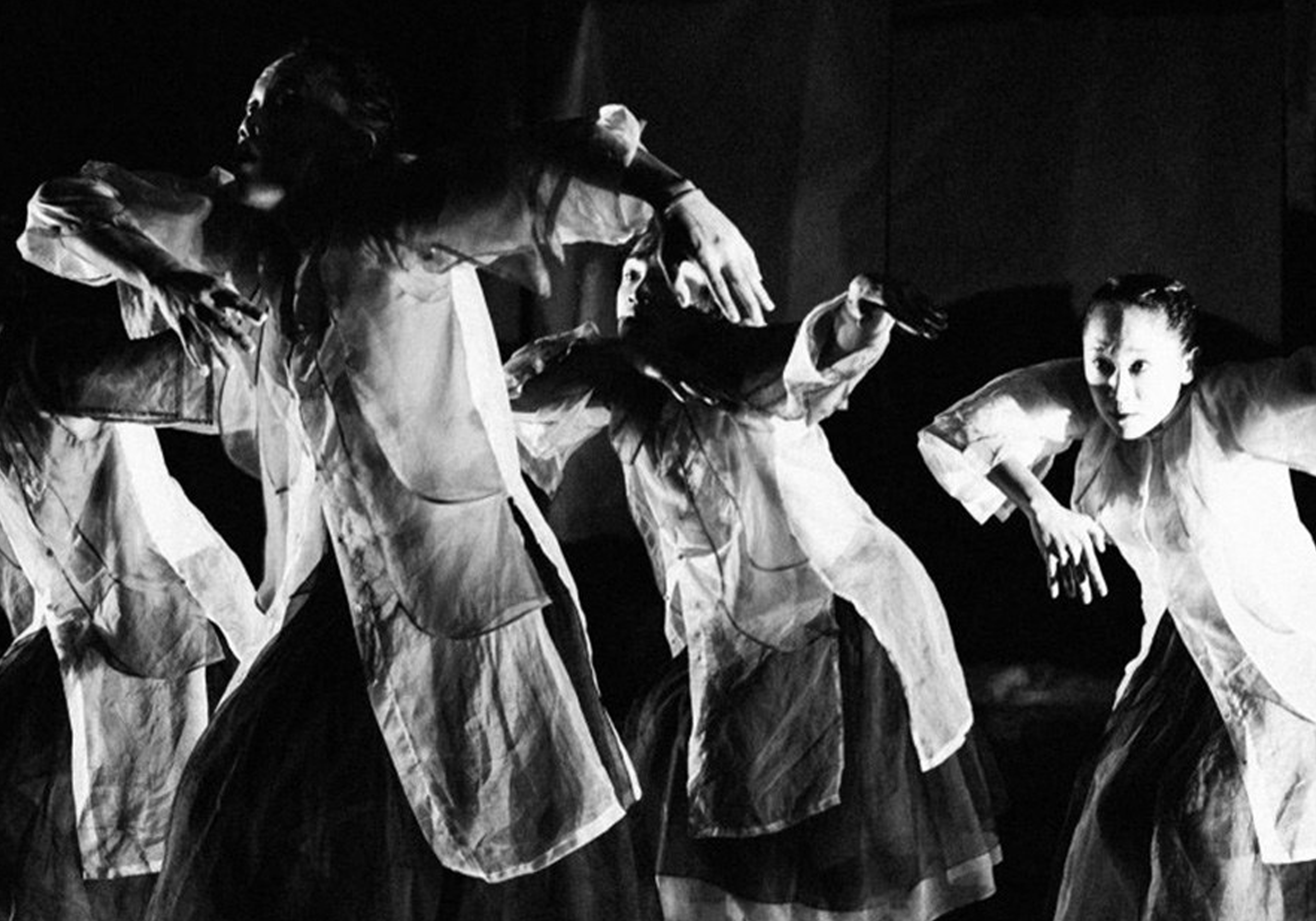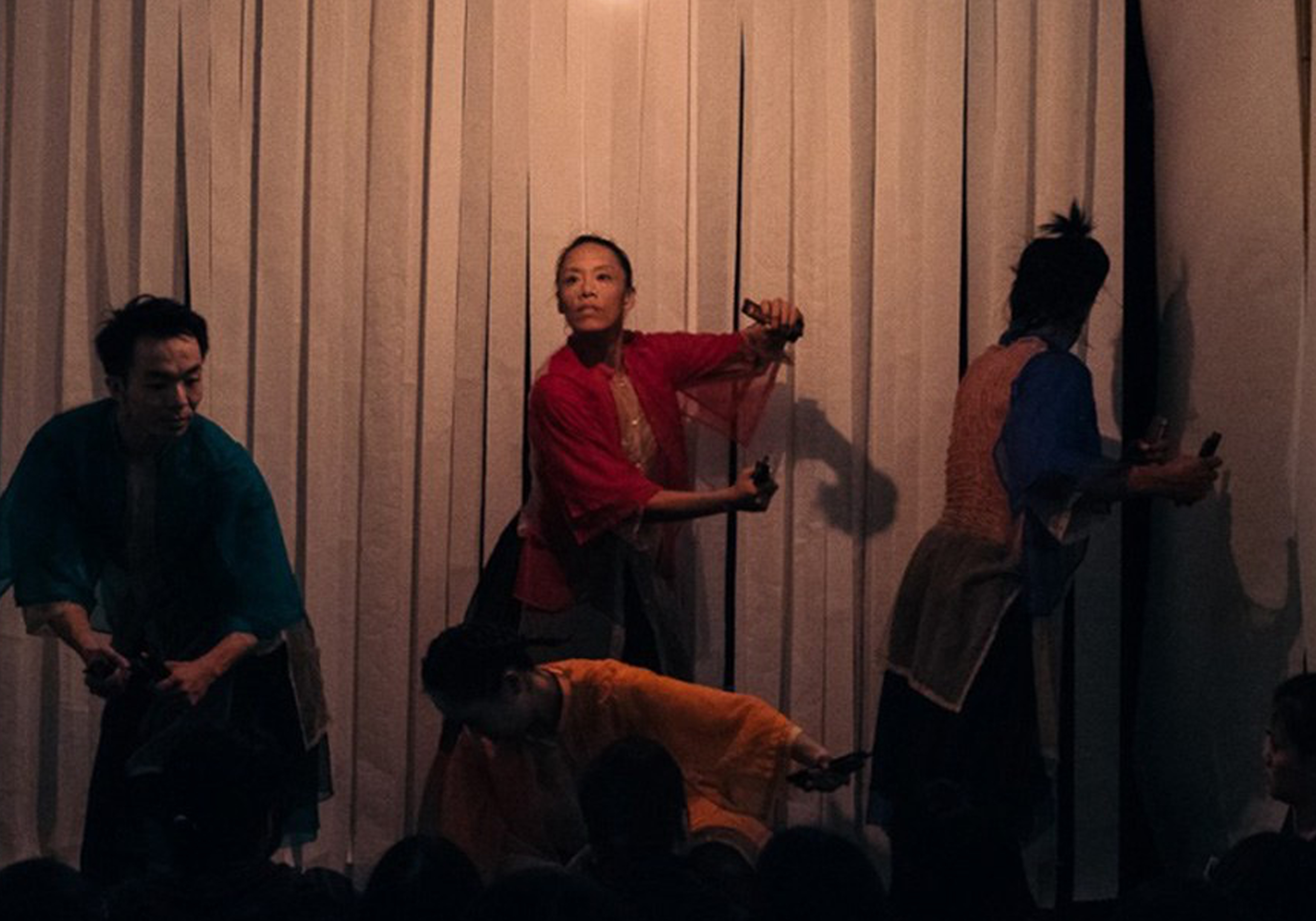《彩虹的盡頭》從「『ㄢˋ』–身體回家五年創作計畫」(2014~2019)開始,逐漸探索、實驗、發展而成,探討生死之於我們究竟有何意義?生命到底是什麼呢?演出以台灣傳統喪葬儀式「牽亡歌」為核心素材,「牽亡歌」是陪伴生者並超渡亡者的儀式;當「牽亡歌」進入劇場,林宜瑾謹慎看待傳統儀式對應劇場之轉化,不讓其成為徒具形符的象徵。從編舞、音樂、服裝、舞台、燈光,所有設計皆扣合主題;透過儀式的精神,深入尋找「身體為何而動」及「台灣人的身體」可能的答案,企圖完整傳統文化之於當代劇場的意義與內涵。
The End of Rainbow began with "Fxxx - Body Returns Home Five-Year Creative Project" (2014 to 2019) and gradually was developed into its current form through exploration and experimentation. The work discusses what life and death mean to us. What is life exactly? The work evolves around "the soul-guiding song" performed in traditional Taiwanese funerals, which is a ritual to accompany the living and release the souls of the deceased from purgatory. Bringing the ritual into theatre, LIN converts it with care by sidestepping the pitfall of turning it into a mere symbol. All the design in the work, including choreography, music, costume, stage, and lighting, corresponds to the theme, and with the spirit of the ritual, the work searches possible answers to questions regarding "what motivates bodily movement" and "the Taiwanese body," attempting to present a comprehensive picture of what traditional culture means to contemporary theatre.
林宜瑾 LIN I-Chin
1983年生於雲林。臺北藝術大學舞蹈創作研究所畢業。曾獲雲林文化獎舞蹈類首獎、世安美學獎表演藝術類首獎並曾於巴黎西帖藝術村駐村。以極專注並細微的觀察力做為創作基底,風格細膩流暢並富有詩意般的美感張力。近期對於一方水土養一方人、身體如何動與如何形成舞蹈有著極大的好奇。並發起「ㄢˋ--身體回家創作計劃」(自2014年至今),此計劃起初是從河洛與的髒話中看見身體的原始動能,至今則發現地氣、意識與身體的相關性。過程中透過田野採集等方法來尋找「ㄢˋ」的當代肢體語彙。現任壞鞋子舞蹈劇場藝術總監、台北藝術大學推廣中心教師。
Born in Yunlin in 1983, LIN I-Chin graduated from the Graduate Institute of Dance, Taipei National University of the Arts. She has won the First Prize in Dance of Yunlin Cultural Award, the First Prize in Performing Arts of S-An Art Award, and an artist residency at the Cité International des Arts, Paris. With acute and keen observation as the foundation of her work, LIN has demonstrated an exquisite and fluent style that conveys poetic beauty and tension. Recently, she becomes interested in how an individual is nurtured by the surrounding environment as well as how dancing is created through the bodily movements. She has initiated and continued "Fxxx - Body Returns Home Five-Year Creative Project" since 2014. The project originated from the primal physical energy LIN discovered through the dirty word in Taiwanese. Through the project, LIN has realized the connection between localness, consciousness, and body. To conduct the project, LIN looks for contemporary body language of "fxxx" through field research. She is the current Artist Director of Mauvais Chausson Dance Theatre and a lecturer at Center for Arts Resources and Educational Outreach, Taipei National University of the Arts.
林宜瑾
陳彥斌、劉俊德、彭子玲、潘靜亞
林仕倫
李慈湄
蔡浩天
江佶洋
劉晏綺
何冠朋
陳藝堂、蔡欣邑、陳又維
廖庭汝
林志洋
林宗範
松菸文創園區──松菸lab實驗室
關鍵字
評審談作品
重新去理解民間臨時性劇場
入圍理由 Comments from Nomination Committee
壞鞋子舞蹈劇場團長林宜瑾長期從傳統文化汲取養分,透過田野方法跟隨牽亡歌者了解牽亡儀式,並將之轉化為《彩虹的盡頭》演出,從題材到展演方式的選擇,都是極大的挑戰。藉著樂聲的牽引,舞者們演繹著亡靈超渡的過程,從生到死到靈,藉著神/人/偶的形象轉喻,將一般人覺得陰晦、避之唯恐不及的喪葬儀典,帶入逼人觀視、聆聽的劇場空間。也因為過/渡、轉/化是牽亡陣的核心,演出也特別透過素材的運用、空間的塑造,讓人體驗進出多維度的情境氛圍。該演出不只讓劇場表演與民俗儀典疊合交遇,也提供我們一種距離美感,重新去理解民間臨時性劇場,對於生命、身體的深刻觀照。(主筆/吳瑪悧)
The work of LIN I-Chin, director of Mauvais Chausson Dance Theatre, has been inspired and nurtured by traditional culture. She adopts the methodology of field research to study the soul-guiding ritual with the ritual's performer, and transforms it into the performance of The End of Rainbow. Whether the subject matter or the approach for the performance, the work has presented great challenges. Through the guiding of the music, the dancers perform the process of releasing the souls of the deceased from purgatory. From life, to death, to spirit, the work employs the images and symbols of gods, humans, and dolls and brings the dark, shunned ritual of funeral into the theatrical space, where the audience must watch and hear. Because the idea of "transition" and ""transformation" lies at the heart of the soul-guiding ritual, the performance also allows the audience to experience the atmosphere of entering and exiting different dimensions through the use of materials and design of space. This work not only combines theatrical performance and folk ritual, it also offers an aesthetic sense of distance that provides a window for us to understand the "temporary folk theatre" and how it attends to life and the physical existence in a profound way. (Commentator: WU Mali)






